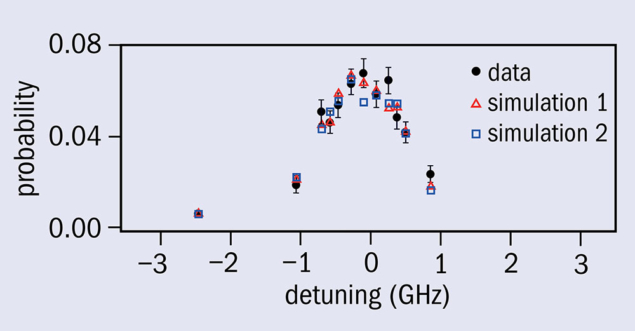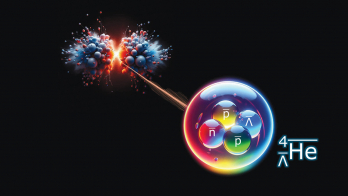
The ALPHA experiment at CERN’s Antiproton Decelerator (AD) has made yet another seminal measurement of the properties of antiatoms. Following its determination last year of both the ground-state hyperfine and the 1S–2S transitions in antihydrogen, the latter representing the most precise measurement of antimatter ever made (CERN Courier May 2018 p7), the collaboration has reported in Nature the first measurement of the next fundamental energy level: the Lyman-alpha transition. The result demonstrates that ALPHA is quickly and steadily paving the way for precision experiments that could uncover as yet unseen differences between the behaviour of matter and antimatter (CERN Courier March 2018 p30).
The Lyman-alpha (or 1S–2P) transition is one of several in the Lyman series that were discovered in atomic hydrogen just over a century ago. It corresponds to a wavelength of 121.6 nm and is a special transition in astronomy because it allows researchers to probe the state of the intergalactic medium. Finding any slight difference between such transitions in antimatter and matter would shake one of the foundations of quantum field theory, charge–parity–time (CPT) symmetry, and perhaps cast light on the observed cosmic imbalance of matter
and antimatter.
The ALPHA team makes antihydrogen atoms by taking antiprotons from the AD and binding them with positrons from a sodium-22 source, confining the resulting antihydrogen atoms in a magnetic trap. A laser is used to measure the antiatoms’ spectral response, requiring a range of laser frequencies and the ability to count the number of atoms that drop out of the trap as a result of interactions between the laser and the trapped atoms. Having successfully employed this technique to measure the 1S–2S transition, ALPHA has now measured the Lyman-alpha transition frequency with a precision of a few parts in a hundred million: 2,466,051.7 ± 0.12 GHz. The result agrees with the prediction for the equivalent transition hydrogen to a precision of 5 × 10–8.
Although the precision is not as high as that achieved in hydrogen, the finding represents a pivotal technological step towards laser cooling of antihydrogen and the extension of antimatter spectroscopy to quantum states possessing orbital angular momentum. Simulations indicate that cooling to about 20 mK is possible with the current ALPHA set-up, which, combined with other planned improvements, would reduce the 1S–2S transition line width (see figure) by more than an order of magnitude. At such levels of precision, says the team, antihydrogen spectroscopy will have an impact on the determination of fundamental constants, in addition to providing elegant tests of CPT symmetry. Laser cooling will also allow precision tests of the weak equivalence principle via antihydrogen free-fall or antiatom-interferometry experiments.
“The Lyman-alpha transition is notoriously difficult to probe – even in normal hydrogen”, says ALPHA spokesperson Jeffrey Hangst. “But by exploiting our ability to trap and hold large numbers of antihydrogen atoms for several hours, and using a pulsed source of Lyman-alpha laser light, we were able to observe this transition. Next up is laser cooling, which will be a game-changer for precision spectroscopy and gravitational measurements.”
Further reading
M Ahmadi et al. 2018 Nature 561 211.







